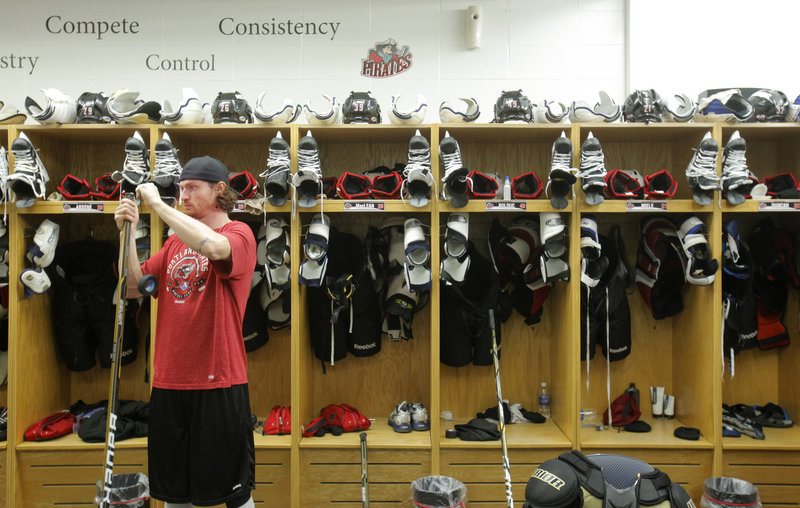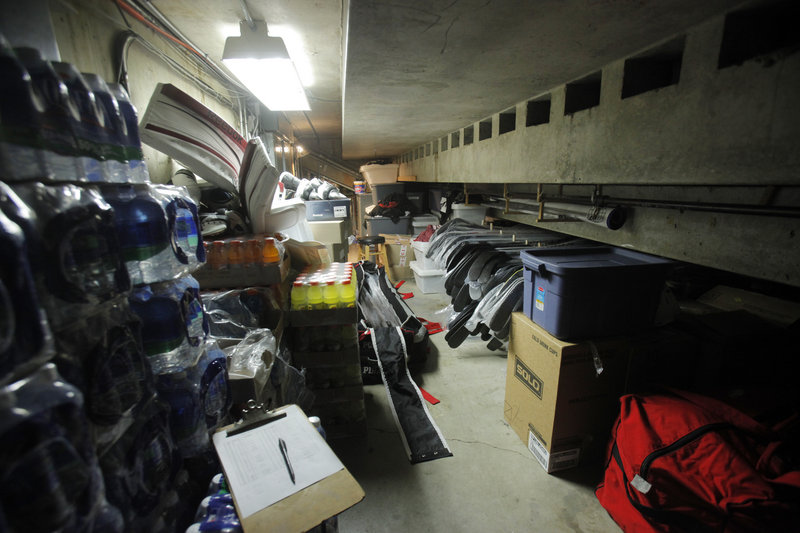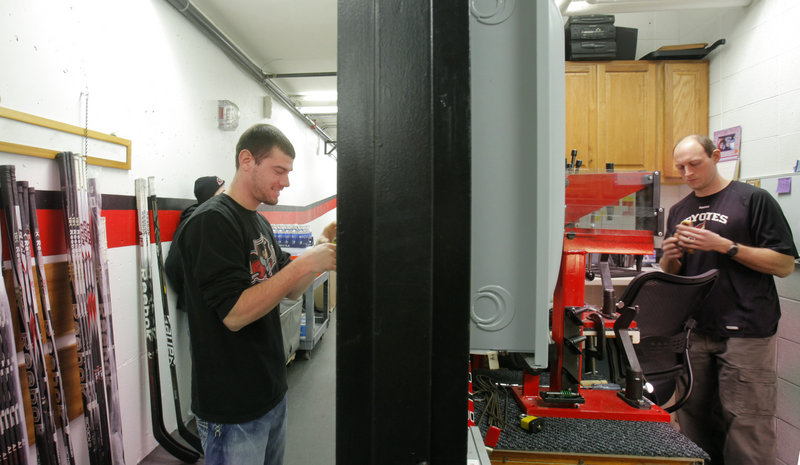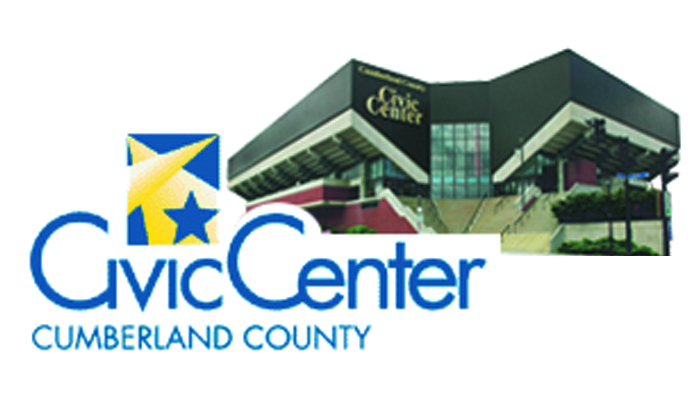Third of three parts
PORTLAND — Over the next four days, some of the area’s best high school basketball teams will have a chance to play their state tournament games at the Cumberland County Civic Center.
It’s a thrill the players will never forget, playing on the big floor before steeply rising stands filled with classmates, parents, neighbors and other basketball fans.
“The atmosphere is great, the facility is great, and the court is in fantastic shape,” said Dan LeGage, coach of the Deering boys. “It’s a really big-time feel for the coaches and the kids.”
But while it may be great on the court, the civic center lacks the basic infrastructure for many sporting events. A college basketball tournament, for example, couldn’t be held there because the locker room space is inadequate to support back-to-back games.
The $33 million renovation approved by county voters last fall is expected to remedy that situation, unchanged for more than three decades. A key part of the project will be major improvements in locker rooms and related space for equipment, training, fitness and other activities.
The Portland Pirates hockey franchise will be a major beneficiary of the upgrades – but so will the high school teams and other athletic groups seeking a modern, functional venue for sporting events.
This week, a few high school teams will dress not in one of three available locker rooms but behind a temporary pipe-and-drape structure of the sort used in trade-show booths, with carpet laid over the concrete floor near the Zamboni machine. At halftime, someone will move their stuff so that, after a team with an early time slot has cleared out, players can shower after their game.
“It’s a pain,” said Jim Leo, a patient man with a walrus mustache who has been operations manager of the civic center since before these teenage athletes were born. “We know it’s a huge deal for the kids to come down here and play, so we do what we can.”
When the civic center’s concrete was drying in 1977, the American Hockey League was finishing up a season with only six franchises. Basketball ruled the state, not hockey, said Steve Crane, civic center general manager.
Designers of the building “never contemplated they’d have a hockey team move in,” he said. And yet that’s exactly what happened, first with the Maine Mariners and then with the Portland Pirates, in 34 of 35 winters.
The home team claimed two of the five locker rooms and swallowed up space for their equipment, for their staff and for their promotional, medical and mechanical needs.
“The shortage of locker rooms has been an immensely crippling defect here,” Crane said. “We’ve worked with it. The (musical) artists have worked with it. The hockey kids have worked with it. But in the end, more locker rooms is a critical aspect of this renovation.”
Last month, engineers used lasers to scan the interior and exterior to give architects precise three-dimensional blueprints.
Ideas abound on how to improve the building – for spectators, performers and the folks who run the operation – but there is finite funding.
“Which is $33 million,” Crane said. “Subsequently, anything that happens in terms of designs and drawings has to fit exactly within that.”
There are physical constraints as well. City streets border all four sides of the civic center, so the footprint can’t expand. Filling in the corners could gain space, and excavation is planned under the patio on the Spring Street side, but ledge prohibits any digging on the Free Street side of the building.
Leo, who started working security at the civic center in 1981 and assumed his current title in 1988, knows the workings of the place better than anyone. On Friday, the three finalists for the job of construction manager toured the building with him to check on conditions and hear his ideas.
The glassed-in lobby on Spring Street where players enter – and where the Mariners had their offices – could be renovated into more locker rooms and expanded space for the Pirates. “Hopefully, we’re going to pick up three, maybe four new locker rooms in that general area,” Leo said. “But again, until they have the dimensions and the piping and all the things down there,” nothing is certain.
An expansion of the Pirates training area four years ago allowed for more weights and stationary bicycles – which now number 12 – and a pair of black couches in a small video area where players can view games on a computer screen.
Assistant coach John Slaney, a member of the 1994 Calder Cup championship team, remembers no more than three or four stationary bikes. In order to lift weights, the players walked to a local gym. He remembers soaking in plastic garbage barrels filled with ice water instead of the stainless steel tubs used today.
So things are better, but still below par. Enjoying the amenities provided to visiting teams at the AHL’s newer arenas makes the civic center’s cramped quarters and out-of-date infrastructure – four shower heads and one sink for 28 sweaty men – even more acute.
“Especially when you go to other buildings that have more things to see, and you come home and you don’t have it,” said Slaney, who enjoyed a 20-year pro career as a player, “it’s a pretty big eye-opener.”
Jon Jennings, president and general manager of the Maine Red Claws, chose the more intimate Portland Expo as the home for his professional basketball team, now playing its third season in the NBA Development League.
“We did a lot of research on different venue sizes and we really wanted to have a smaller building,” Jennings said. “We thought 3,000 to 4,000 would be a perfect number.
“The civic center is 7,000 or 8,000 for basketball. We just thought that was too big for what we were trying to accomplish.”
Jennings said the Expo also reminded him, on his first visit, of the old Boston Garden. It certainly needed work, but it also exuded a sense of warmth lacking in the cold concrete of the civic center.
Even so, Jennings is part of a development group hoping to build a $105 million mixed-use complex on Thompson’s Point in Portland that would include a 3,500-seat basketball arena.
“We want to maintain the intimacy of the building,” Jennings said, “but with updated, modern amenities.”
Back inside the civic center, the Pirates’ equipment manager, John Krouse, orders all players to remove their shoes before entering the training room to prevent road salt or grit from getting into the carpet and possibly fouling a skate blade.
A recent workout looked like a giant play-date with 19 pairs of sneakers, shoes and slippers lined up in the hallway.
Krouse’s small office doubles as the laundry room – with a washer and two dryers – and triples as repair shop and skate-sharpening center.
“We get three people in here and it’s jammed,” he said. “It’s manageable, but it’s a pain in the butt.”
Krouse lives large compared to trainer Mike Booi, who shares space with two whirlpool tubs and two training tables. “He doesn’t even have a desk,” Krouse said. “He just sits on a training table and does his work.”
Both Booi and Krouse dream of a renovation that includes team benches moved to the Spring Street side of the ice to allow in-game access to locker rooms. A quick suture or skate repair could be done without a player missing his shift, rather than waiting for whistles to stop play and allow passage off the ice, then back on again.
“It’d be unreal,” Booi said. “But I’ve been around to a couple of old barns like this and it’s all about the same. You kind of expect it.”
Finding more space, and making better use of the available space, is the challenge awaiting architects and the civic center’s board of trustees. Neal Pratt, chairman of that board, said he expects a reliable construction schedule by mid- to late March.
“We certainly want to create more opportunities for the civic center to bring sporting activity into the state,” Pratt said.
“I would love to host some of the regional college tournaments.”
LeGage, the Deering basketball coach, also welcomes the renovation, mostly because he thinks it bodes well for the city. Amenities and locker rooms are nice, but the best aspect of a game at the civic center is being on the floor with electricity in the air.
“Kids are pretty resilient,” he said. “They’ll adjust. They’re just happy to be there.”
Jim Leo, after decades of making do, is looking forward to a little bit more.
Staff Writer Glenn Jordan can be contacted at 791-6425 or at: gjordan@pressherald.com
Send questions/comments to the editors.






